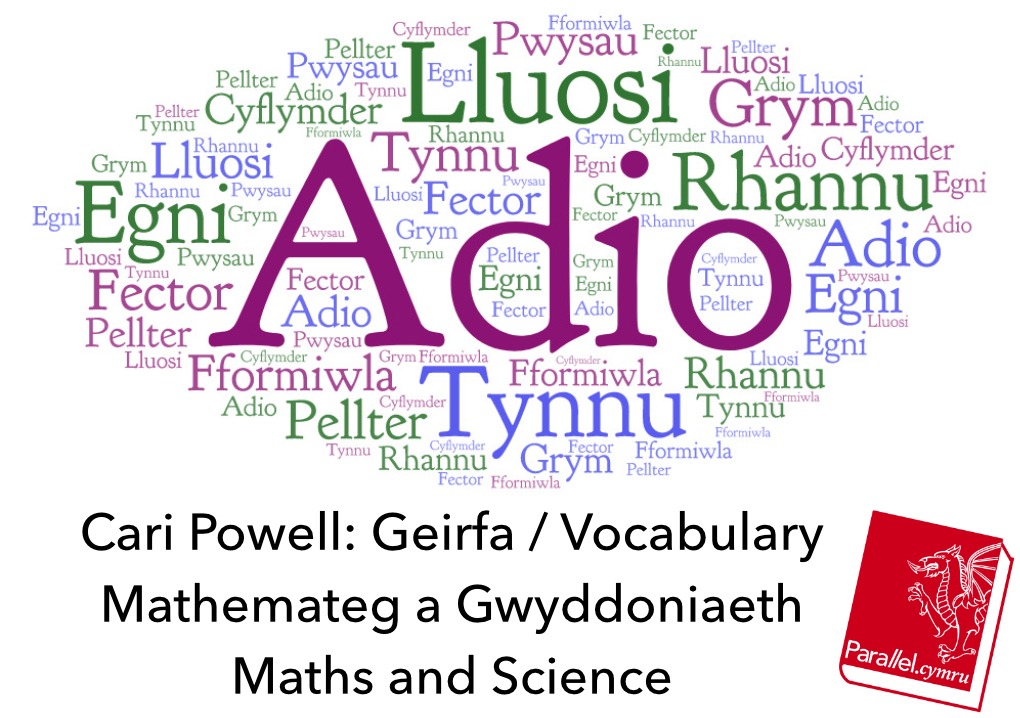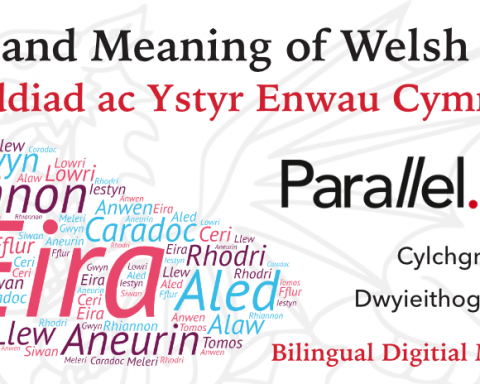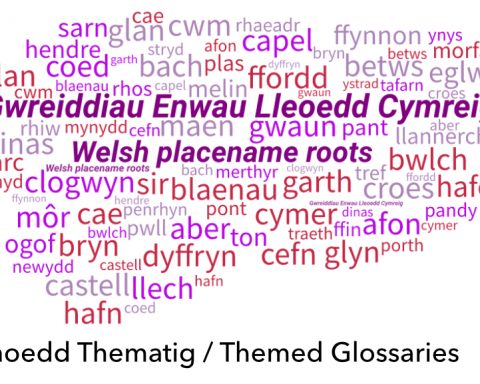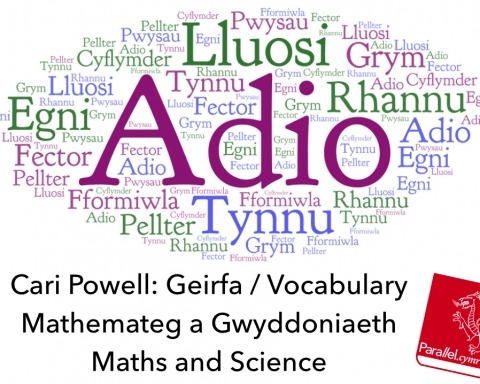Gan Cari Powell, myfyriwraig PhD ym Mhrifysgol Abertawe, a’i phwnc arbenigol yw Ffiseg a Chosmoleg.
By Cari Powell, a PhD student in Swansea University, whose speciality subject is Physics and Cosmology.
Termau Cyffredinol / General Terms
Mae'r holl ddelweddau a ddefnyddir wedi'u credydu i NASA.
All images used are credited to NASA.
Seren - Sffêr goleuol o hydrogen a heliwm lle ma ymasiad niwclear yn digwydd ac yn cael ei chynnal at a'i gilydd gan ei disgyrchiant ei hun. Esiampl o hon ydy'r Haul.
Star - A luminous, spherical object made of hydrogen and helium, that undergoes nuclear fusion and is held together by its own gravity. An example of this is the Sun.
Planed - Gwrthrych wybrennol sy'n cylchdroi o gwmpas seren. Mae gan blaned digon o fàs ar gyfer hunan-disgyrchiant i wrthwynebu grymoedd cyrff anhyblyg fel y bydd yn cymryd siâp bron crwn. Mae ganddi ddisgyrchiant digon cryf nes mai dim ond ei lloeren naturiol sy'n troelli o'i hamgylch.
Planet - Celestial object which orbits around a star and has enough mass to self-gravity to overcome rigid-body forces so that it assumes a nearly round shape. It also is gravitationally dominant so that the only thing that orbits around it are natural satellites.
Blwyddyn - Y cyfnod o amser y mae'r Ddaear yn ei gymryd i symud o gwmpas yr Haul.
Year - The time taken for a planet to orbit around the Sun.
Diwrnod - Y cyfnod o amser ymae'r Ddaear yn ei gymryd i gylchdroi ar ei echelin unwaith.
Day - The time it takes for a planet to turn on its axis.
Lleuad - Lloeren naturiol sy'n cylchgroi o gwmpas planed neu planed bach.
Moon - Natural satellite that orbits around a planet or a minor planet.
Comed - Carreg rewedig sy'n gollwng nwy (ar ffurf cynffon) pan fydd yn pasio yn agos i'r Haul oherwydd y tymheredd uchel.
Comet - An icy rock which releases gases (like a tail ) due to the high temperature of the Sun when the comet passes close to it.
Asteroid - Gwrthrych bach wedi'i 'neud o garreg a sy'n cylchdroi o gwmpas yr Haul. Ceir y rhan fwyaf ohonyn rhwng Mawrth a Iau (Y Gwregys Asteroid).
Asteroid - A small, rocky object that orbits the Sun. They are most commonly found between Mars and Jupiter (Asteroid Belt).
Meteor - Corff wedi'i 'neud o fetel neu garreg, sy'n llai nag asteroid.
Meteor - A body made of rock or metal which is smaller than an asteroid.
Galaeth - Grŵp dirfawr o sêr, nwy a llwch a gynhelir gyda'i gilydd gan ddisgyrchiant. Mae Twll Du Gorfasfawr yng nghanol y mwyafrif o alaethau, siŵr o fod.

Galaxy - A system of stars, gas and dust that is held together by gravity of a Supermassive Black Hole found at the centre.
Y Bydysawd - Yr hyn sy'n cynnwys popeth, hynny yw, gofod ac amser i gyd, yn ogystal â'r holl planedau, y sêr, y galaethau a phob math o fater ac egni.
The Universe - Contains everything, all space and time ( planets, stars, galaxies, all types of matter and energy).
Cosmoleg - Adran o Ffiseg sy'n astudio dechreuad ac esblygiad y Bydysawd.
Cosmology - Branch of Physics which studies the beginnings and evolution of the Universe.
Seryddiaeth - Adran o ffiseg sy'n astudio'r planedau, y sêr a'r chyrff eraill yn y Bydysawd.
Astronomy - A section of physics which studies space and the objects that are found in the Universe.
Astroffiseg - Adran o seryddiaeth sy'n astudio'r sêr.
Astrophysics - A branch of astronomy which focuses on the study of stars.
Cysawd yr Haul / Solar System
Yr Haul - Y seren yng nghanol ein cysawd, y mae'r planedau yn cylchdroi o'i chwmpas. Mae'n seren brif ddilyniant, gyffredin efo tymheredd arwynebol o 5,505 gradd celciws. Mae'r Haul yn cynnwys elfennau drwm a chredir a'i ffurfiwyd o weddillion sêr llawer mwy.

The Sun - The star at the centre of the Solar System which all the planets orbit around. It is an average main sequence star with a surface temperature of 5505 degrees Centigrade. It contains heavier elements within it as it is thought to be made from the remnants of much larger stars.
Mercher - Planed greigiog sydd agosaf i'r Haul anid oes ganddo atmosffer. Mae'n cymryd yr un faint o amser i'r blaned gylchdroi'r Haul fel y mae'n ei wneud i gylchdroi ar ei echelin ("tidally locked"). Mae blwyddyn ar Mercher tua 88 diwrnod o hyd. Mae'r tymheredd lleiaf (ochr oddi wrth o'r Haul) ydy -170 gradd celciws a'r tymheredd mwyaf (ochr sydd yn wynebu'r Haul) yw 449 gradd celciws.

Mercury - Rocky planet which is the closest to the Sun. It has no atmosphere and it is tidally locked to the Sun. A year on Mercury is roughly 88 days. Its minimum temperature ( side not facing the Sun) is -170 degrees Celsius and the maximum temperature ( side facing the Sun) is 449 degrees Celsius.
Gwener - Yr ail blaned o'r Haul. Mae'n debyg i'r Ddaear mewn maint. Mae ganddi'r atmosffer mwyaf dwys o'r pedair planed daearol (> 96% CO2). O ganlyniad, mae'n dwymach ar ei hwyneb na Mercher 462oC (digon dwym i doddi plwm). Na allwn ni weld wyneb y blaned oherwydd y cymylau trwchus o asid sylffwrig. Mae'n cylchdroi mor araf bod diwrnod ar Wener yn hirach na blwyddyn ar y Ddaear (diwrnod = 243 diwrnod, blwyddyn = 224 diwrnod). Rydym yn gallu gweld Gwener (Seren y Gohwyr, neu Seren Fore) o'r Ddaear .
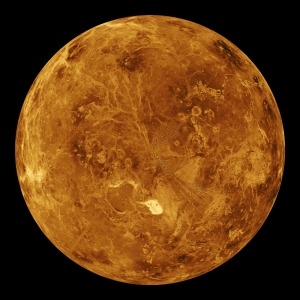
Venus - Second planet from the Sun and is similar in size to the Earth. It has the densest atmosphere of the four terrestrial planets ( > 96% CO2). As a result it has a hotter surface temperature than Mercury of 462oC( hot enough to melt lead). The surface of the planet can't be seen due to the high layer of reflective sulphuric clouds in the atmosphere. It rotates so slowly that a day on Venus (243 days) is longer than a year (224 days). It can be seen from Earth as the Evening Star.
Y Ddaear - Y drydydd planed o'r Haul a'r unig un yng Nghysawd yr Haul sy'n gallu cynnal bywyd deallus (mae'i hatmosffer yn 70% nitrogen). Mae hyn yn bosibl oherwydd bod y blaned yn y rhanbarth "Goldilocks" (nid yw'r blaned yn rhy agos neu'n rhy bell i ffwrdd o'r Haul). Mae ei maes magnetig yn ei hamddiffyn o gwynt yr Haul sy'n cael ei weld fel Golau'r Gogledd. Y Ddaear yw'r blaned agosach i'r Haul sydd â lleuad yn gylchdroi o'i hamgylch.
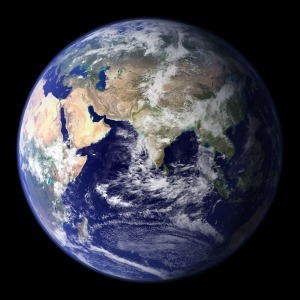
Earth - Third planet from the Sun with an atmosphere which is 70% nitrogen and is only one that is known to have the capacity to sustain life in the Solar System . It is in the "Goldilocks" zone ( not too close or too far away from the Sun). Its magnetic field protects it from the Solar wind which can be seen as the Northern Lights. It is the closest planet to the Sun which has a moon orbiting around it.
Y Lleuad - Lloeren naturiol y Ddaear. Mae ei tharddiad yn anhysbys ond mae yna cwpl o syniadau. Naill ai cafodd asteroid mawr wedi cael ei ddal yng nghylch o amgylch y Ddaear neu wnaeth corff maint Mawrth daro'r Ddaear gan achosi i gylch o falurion ffurfio cyn casglu at ei gilydd i greu'r Lleuad. Mae wyneb y Lleuad yn llawn craterau a ffurfiwyd gan asteroidau a meteorau'n taro yn ei herbyn.

The Moon - The Earth's natural satellite with an unknown origin. However there are a couple of ideas of how it came to be our moon. Either a large asteroid was captured in the orbit of the Earth or a Mars-sized object collided with Earth throwing up a ring of debris which eventually collected together to become the Moon. Its surface is covered in craters due to the impact of asteroids and meteors.
Mawrth - Planed ddaearol sy'n bellach o'r Haul na'r Ddaear. Mae'n goch oherwydd y haearn ocsid ar wyneb y blaned. Mae ganddo gapiau iâ pegynol yn debyg i'r Ddaear (yn cynnwys iâ dŵr). Hefyd mae ganddo craterau ardrawol fel y mae ar y Lleuad. Mae ganddo llosgfynydd anweithredol, Olympus Mons sydd bron yn dair gwaith yn fwy na Mynydd Everest (22,600 o droedfedd). Phobos a Deimos ydy'r enwau ar ei ddwy leuad, sydd yn ddau asteroid a gafodd a ddaliwyd yng nghylch y blaned.

Mars - Furthest terrestrial planet from the Sun with a red surface consisting of iron oxide. It has polar caps similar to the Earth as they contain water ice. Its large inactive volcano Olympus Mons is almost three times the size of Earth's Mt. Everest , standing at 22,600 ft. It has impact craters similar to the Moon on its surface. It has two natural satellites, Phobos and Deimos which are two asteroid which were captured in Mars' orbit.
Gwergys Asteroidau - Cylch o asteroidau rhwng Mawrth ac Iau.

Asteroid Belt - A ring of asteroids between Mars and Jupiter.
Iau - Y blaned mwyaf yng Nghysawd yr Haul. Yn wahanol i'r planedau daearol mae Iau yn Gawr Nwy. Mae'r mwyafrif o'r blaned yn cynnwys o hydrogen a heliwm (tua 25% o'r blaned yw helium). Dywedir bod ganddo craidd creigiog wedi'i wneud o elfenau trwm. Mae'n 2.5 gwaith yn fwy o ran diameder na gweddill y blanedau eraill gyda'i gilydd. Mae disgyrchiant ar ben atmosffer Iau yn 2.5 gwaith disgrychiant ar y Ddaear.
Un o'i nodweddion unigryw ydy'r Smotyn Mawr Coch sy'n storm anferth efo cyflymder gwynt o tua 384 mya, tra mae'r stormydd cryfaf ar y Ddaear yn teithio tuag at 200 mya. Gwelwyd y storm yn 1830. Ond pobl yn arsyllu ar Iau yn 1665 a 1713 oedd hefyd yn gwylio storm, a heddiw mae rhalle mae rhai'n credu bod y storm welodd yr arsylwyr cyntaf oedd yr un un, ac felly ei bod hi wedi bodoli am o leiaf 350 o flynyddoedd!
Mae ganddo 79 o leuadau (ar hyn o bryd, efallai bod mwy i'w ddarganfod), a'r un fwyaf ydy Ganymede sydd â diamedr yn mwy na Mercher. Fel Sadwrn mae cylchoedd o amgylch Iau, ond maen nhw'n wan, ac wedi'u gwneud yn bennaf o lwch.

Jupiter - The largest planet in the Solar System. Unlike the terrestrial planets it is primarily composed of hydrogen and 25% helium. It is said to have a rocky core made from heavier elements. It's 2.5 times the size of all the other planets combined (2.5 times the gravity of Earth).
One of its distinctive features is the massive storm of known as the Great Red Spot, which is large enough to contain 3 Earth size planets within it. Wind speeds are around 384 mph while storms on the Earth reach a maximum of about 200 mph! It has been observed since 1830, however, early observations of the planet in 1665 and 1713 assume that the storm that's been observed is the same one. If that's true then the storm has existed for at least 350 years!
It has 79 moons (at present, more may be discovered in the future), the largest of which is Ganymede with a diameter larger than Mercury. Like Saturn, Jupiter has a system of rings but these are much fainter, consisting mainly of dust.
Sadwrn - Y blaned hon yw'r ail fwyaf yn Nghysawd yr Haul. Mae o'i amgylch set o gylchoedd nodedig o'i amgylch wedi'u gwneud bennaf o iâ dŵr. Mae'r craidd yn nicel a charreg wedi'i gwneud o silicon ac ocsigen. Mae hydrogen metalaidd yn amgylchynu'r craidd ac ar ben hwn mae hydrogen a helium hylifol, a haen allanol o nwy. Crisialau amonia yn yr atmosffer uchaf sy'n achosi'r lliw melyn.
Mae gan Sadwrn 62 o leuadau, a'r un fwyaf adnabyddus yw Titan. Mae gan Titan lifogydd mawr llawn hydrocarbonau ac mae gwyddonwyr yn meddwl bod yna ddŵr hylifol o dan wyneb y lleuad.
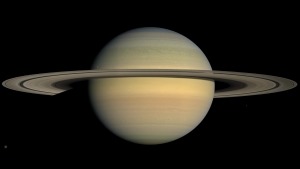
Saturn - The second largest planet in the Solar System famous for its distinctive set of rings which are made primarily from water ice. The planet has a nickel and rock (made from silicon and oxygen compounds) core. Surrounding the core is metallic hydrogen and above this is liquid hydrogen and helium with a gaseous outer layer. It is is yellow in colour because of ammonia crystals found in the upper atmosphere.
Saturn has 62 moons, the most well known being Titan. Titan has large hydrocarbon lakes where liquid water is believed to be beneath the surface.
Wranws - Mae'r blaned yma yn enwog am droelli ar ei ochr (o'i chymharu ar blanedau eraill) am i garreg tua'r yr un maint a'r Ddaear wrthdaro efo hi pan oedd yn blaned ifanc, cyn i'r lloerenau a'r cylchoedd ffurfio o'i hamgylch. O ganlyniad, mae'r lloerenau yn gylchdroi o gwmpas y pegynau.
Cafodd y cylchoedd eu chreu o leuadau a chwalwyd oherwydd disgyrchiant Wranws. Mae'r atmosffer yn debyg i Iau a Sadwrn. Fodd bynnag, mae Wranws yn fwy iâ, yn cynnwys dŵr, amonia a methan, a dyna sydd pam mae'r blaned yn las, a hefyd pam mae'n cael ei henwi yn gawr iâ .
Mae gan Wranws 27 lleuad hysbys. Yr un fwyaf ydy Titania a hon yw'r wythfed fwyaf yng Nghysawd yr Haul (i'w gymharu efo'r Lleuad sydd y pumed fwyaf).

Uranus - Third largest planet after Jupiter and Saturn which is famous for rotating on its side. This was due to the when the planet was young an Earth sized object hit the planet before the moons began orbiting around it and the ring system formed. As a consequence, the moons orbit the poles.
The rings were formed by moons which had shattered due to Uranus' gravity and the moons rotate around the poles. Its atmospheric composition is similar to the two larger planets however it also consists of ice which is primarily water, methane and ammonia giving Uranus its blue colour. Because of this it is known as an ice giant.
It has 27 known moons and the largest of these is Titania. Titania is the eighth largest moon in the system ( in comparison with our Moon which is the 5th largest).
Neifion - Y blaned bellach o'r Haul, a'r dwysaf, yw Neifion. Mae'n 17 gwaith màs y Ddaear ac yn debyg mewn maint i Wranws. Mae'r atmosffer yn debyg i'r cweri nwy eraill, yn enwedig Wranws, ohwerydd y iâ dŵr, methan ac amonia yn yr atmosffer. Mae'r rhain yn peri i'r blaned ymddangos yn las tywyll. Felly, mae Neifion yn gawr iâ hefyd.
Fel Iau, mae ar Neifion stormydd enfawr, sydd i'w gweld fel Smotiau Enfawr Tywyll, ond mae'r gwyntoedd ar Neifion yn llawer cryfach na'r Smot Mawr Coch ar Iau. Mae'r stormydd ar Neifion yn cyrraedd tua 1,500 mya, bron yn bum gwaith yn fwy na Iau! Mae o gwmpas Neifion system o gylchoedd hefyd, yn cynnwys iâ a silicates.
Ar hyn o bryd rydym yn gwybod mai gan Neifion 14 o leuadau. Y fwyaf ydy Triton, sydd y seithfed fwyaf yn Nghysawd Yr Haul. Credir bod Triton yn wrthrych o'r Gwergys Kuiper oherwydd ei fod yn cynnwys deunydd yn debyg i'r hyn a geir ar Blwton. Mae'i wyneb yn hydrogen sydd wedi rhewi, y gramen yn iâ dŵr, mae ganddo fantell rewledig a chraidd wedi'i wneud yn bennaf o charreg a metal.
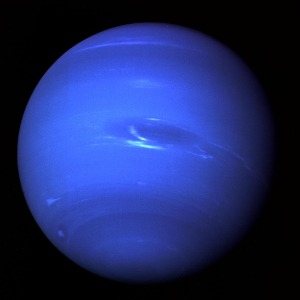
Neptune - Furthest planet from the Sun, and the densest (17 times the mass of the Earth). It's similar in size and composition to its neighbour Uranus (hydrogen and helium like all gas giants and ice made from water, ammonia and methane) which gives it its dark blue colour.
Like Jupiter, Neptune has a large storm spot called the Great Dark Spot which experiences the strongest winds in the Solar System. Winds reach up to 1,500 mph which is about 5 times more than the Great Red Spot on Jupiter! Neptune, like the rest of the gas giants has a system of rings however its rings are made of ice and silicate.
At present it has 14 known moons, the largest being Triton, which is the seventh largest moon in the solar system overall. It was thought to be an object from the Kuiper Belt captured in Neptune's gravity as it has a similar composition to Pluto. The surface is made of frozen hydrogen, below that is a crust made of mostly water ice, the next layer is the icy mantle and this surrounds the rock and metal core.
Plwton - Corblaned yn y Gwergys Kuiper. Pan gafodd ei darganfod, ystyriwyd Plwton fel y blaned bellach o'r Haul, ond cafodd ei diraddio i fod yn ddim ond corblaned. Digwyddod hyn oherwydd bod yna wrthrychrau bron mor fawr â hi yng Ngwergys Kuiper, ac mae'i lleuad Charon bron mor yr un maint â hi hefyd. Oherwydd ei chylch eliptig, mae Plwton weithiau yn agosach i'r Haul na Neifion. 98% o wyneb Plwton ydy iâ nitrogen.

Pluto - Dwarf planet found in the Kuiper Belt. It was considered a planet however there are objects in the Kuiper Belt which are almost as large as Pluto and its moon Charon is about the same size as it. Its eccentric elliptical orbit means that sometimes it is closer to the Sun than Neptune. The surface is 98% nitrogen ice.
Gwergys Kuiper - Cylch llawn asteroidau sy'n debyg i'r Gwregys Asteroidau ond yn llawer mwy (mae'n 20 gwaith yn ehangach a rhwng 20 a 200 gwaith mwy masfawr). Plwton yw'r gwrthrych mwyaf yn y gwregys.

Kuiper Belt - Ring of asteroids, similar to the Asteroid Belt but a lot bigger ( 20 times as wide and between 20 and 200 times more massive). Pluto is the largest object within the belt.
Y Bydysawd eang / The wider Universe
Cytser - Grŵp o sêr sy'n creu amlinell gwrthrych, anifail neu greadur chwedlonol.
Constellation - A group of stars that creates the outline of an object, animal or a mythical creature.
Twll Du - Seren enfawr a wnaeth mewnffrwydro o dan ei disgyrchiant i greu unigolrwydd ydy twll du. Mae'r disgyrchiant yno mor gryf na all unrhyw mater neu golau dianc rhag atyniad y twll du, oddi mewn i'w orwel digwyddiad
Black Hole - An enormous star which collapsed under its own weight to become a black hole. The gravitational pull from a black hole is so strong that no matter or light can escape it from inside its event horizon.
Tonnau Disgyrchiant - 'Cylchdonnau' fydd yn mynd trwy ofod-amser oll, pan fydd rhywbeth catastroffig yn digwydd (e.e. pan fydd dau twll du yn cyfuno).
Gravitational Waves - Ripples in space and time caused by a large astrophysical event (e.g. two black holes colliding).
Mater Tywyll - 80% o mater yn y Bydysawd yn anhysbys, ac oherwydd rydym yn defnyddio'r enw 'mater tywyll'. Nid ydym yn siŵr beth mae'n ei gynnwys, ond rhaid bod rhyw fath o 'stwff newydd' yn bodol, er mwyn cadw'r galaethau at eu gilydd!
Os ydych yn dymuno dod o hyd i fwy o wybodaeth am fater tywyll, dyma erthygl gynhwysfawr amdano: parallel.cymru/cari-powell-mater-tywyll
Dark Matter - 80% of the matter in the universe is invisible and as a result we use the term 'dark matter'. We're not sure what it's made of, but there has to be some 'new stuff' that exists to holds the galaxies together.
For more info here's a more in depth article: parallel.cymru/cari-powell-mater-tywyll
Egni Tywyll - Ffurf anhysbys ar egni sydd yn achosi i'r Bydysawd ehangu, yn ôl damcaniaethau diweddar .
Dark Energy - Unknown form of energy which is believed to be the source for the expansion of the universe, according to the latest research.



